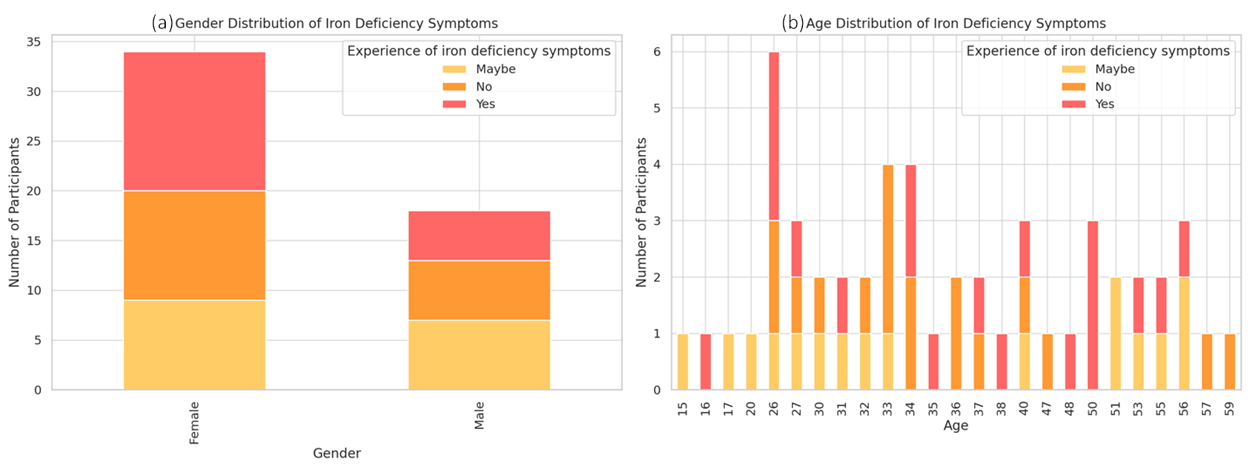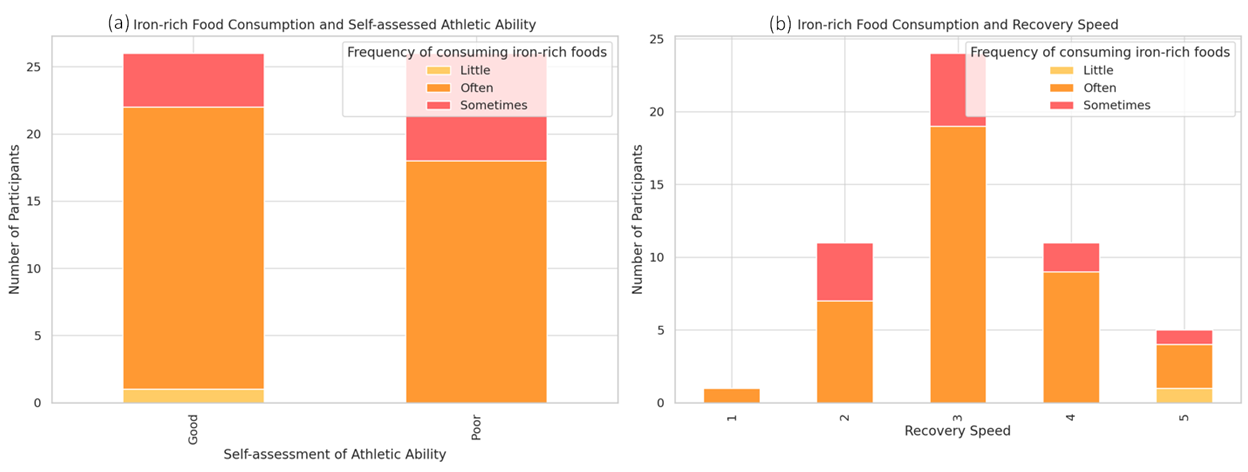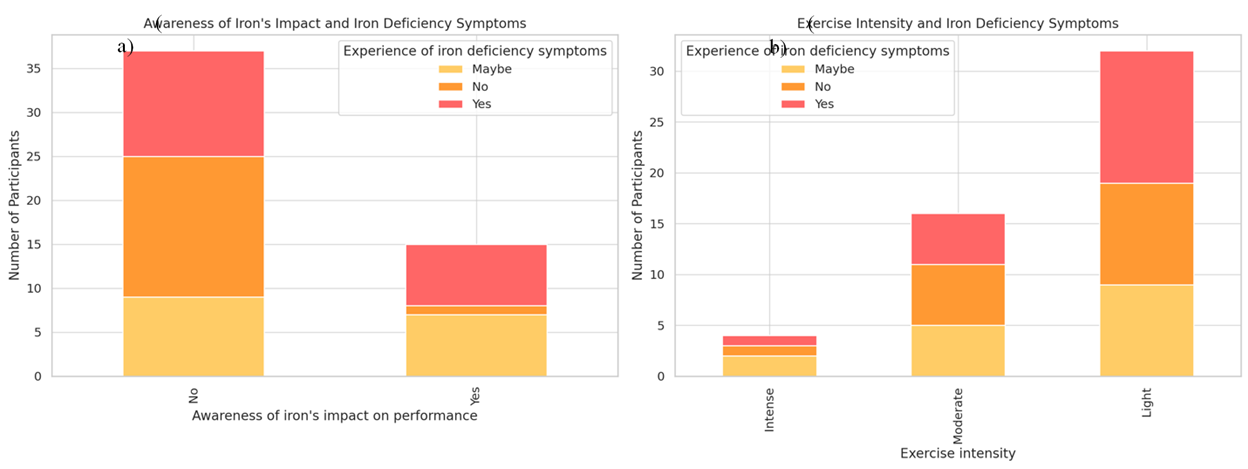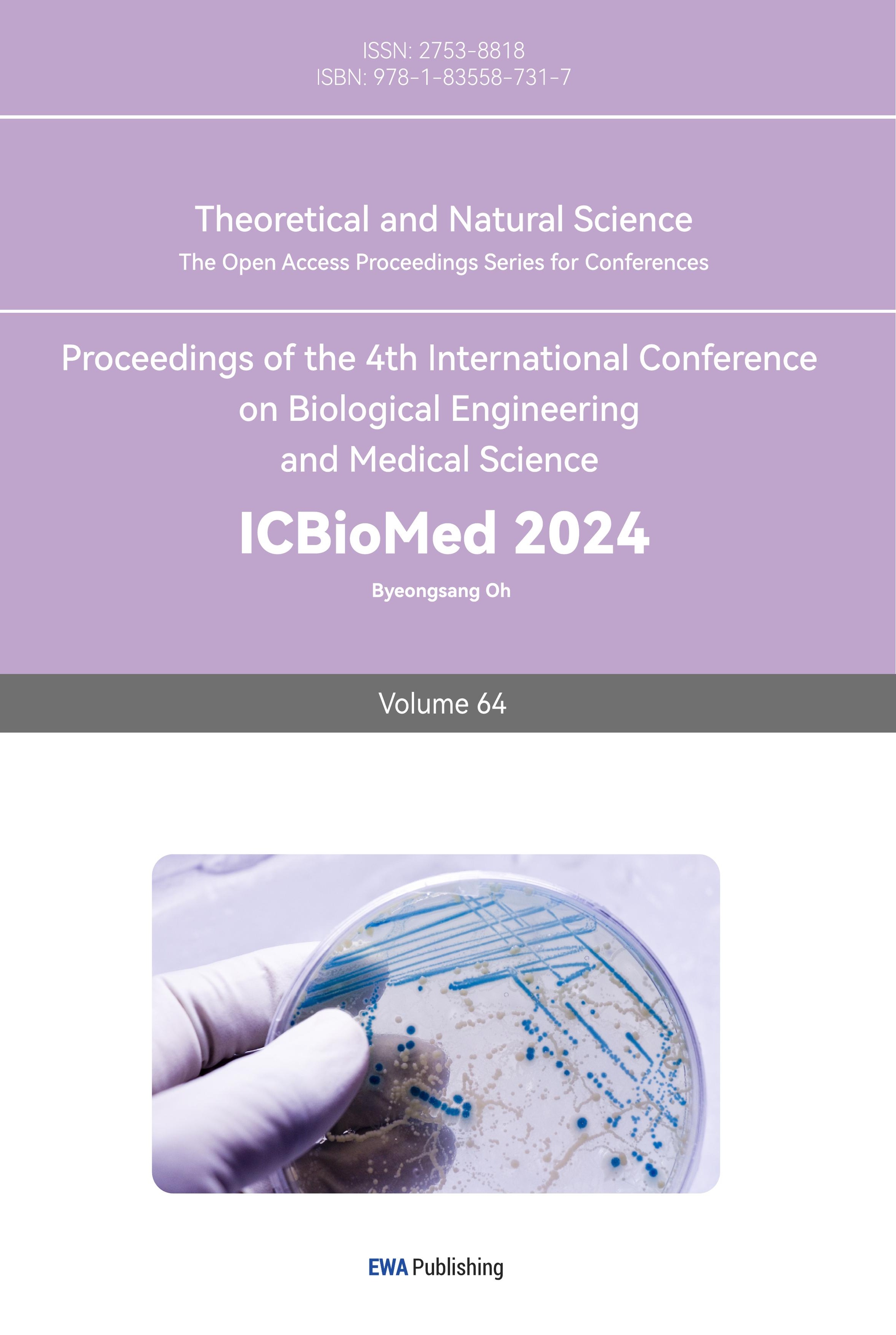1. Introduction
Iron is a vital mineral that plays a crucial role in various physiological processes essential for athletic performance. It is a key component of hemoglobin, the protein in red blood cells responsible for transporting oxygen from the lungs to the muscles. This oxygen transport is fundamental to energy production in the muscles, particularly during aerobic activities where sustained energy output is required. Without adequate iron, the body's ability to deliver oxygen to working muscles is compromised, leading to fatigue, reduced endurance, and impaired athletic performance [1].
The importance of iron extends beyond its role in oxygen transport. Iron is also a critical component of myoglobin, another oxygen-binding protein found in muscle tissue, and various enzymes involved in energy metabolism. These functions are particularly important for athletes, whose energy demands are significantly higher than those of the general population. The ability to maintain optimal iron levels is thus crucial for athletes to perform at their best.
Iron deficiency is one of the most common nutritional deficiencies worldwide, affecting both the general population and athletes. However, athletes, particularly those engaged in endurance sports such as long-distance running, cycling, and swimming, are at a higher risk of developing iron deficiency due to several factors. These include increased iron losses through sweat, gastrointestinal bleeding, and hemolysis, which occurs when red blood cells are damaged during high-impact activities [2]. Additionally, the dietary habits of athletes, which may prioritize carbohydrate and protein intake over micronutrients like iron, can contribute to suboptimal iron levels.
Female athletes are particularly vulnerable to iron deficiency due to the additional iron losses associated with menstruation. Studies have shown that iron deficiency, even without anemia, can impair muscle function, reduce exercise capacity, and negatively affect cognitive function and overall health [3]. The implications of iron deficiency in female athletes are especially concerning given the potential for decreased performance and increased injury risk, which can have long-term consequences for their athletic careers.
Understanding the prevalence and impact of iron deficiency in different athletic populations is essential for developing effective nutritional strategies and interventions. Iron-rich foods such as red meat, beans, nuts, and leafy green vegetables are crucial dietary components for preventing iron deficiency. The bioavailability of iron varies significantly between dietary sources, with heme iron from animal products being more readily absorbed compared to non-heme iron from plant sources [4]. However, the bioavailability of iron from plant sources (non-heme iron) is generally lower than that from animal sources (heme iron). The absorption of non-heme iron can be enhanced by consuming it with vitamin C-rich foods, which convert iron to a more absorbable form [5]. This knowledge is particularly relevant for athletes who follow vegetarian or vegan diets, as they may need to pay extra attention to their iron intake to avoid deficiency.
Iron supplementation is another common strategy to prevent or treat iron deficiency in athletes. Research indicates that iron supplementation can significantly improve iron status and aerobic capacity in athletes with iron deficiency [6]. Proper iron supplementation is crucial for athletes, particularly those at risk of deficiency, as it can significantly improve iron status and, consequently, athletic performance [7]. However, iron supplementation must be carefully managed, as excessive iron intake can lead to adverse effects, including gastrointestinal discomfort and oxidative stress [8]. Therefore, individualized supplementation plans, guided by regular monitoring of iron levels, are recommended to ensure that athletes receive the appropriate amount of iron without risking toxicity.
Given the critical role of iron in athletic performance, this study aims to explore the awareness and perceptions of athletes regarding the impact of iron on their performance. It seeks to identify potential gaps in knowledge and behavior that can be addressed through targeted educational programs. By understanding athletes’ awareness and behaviors related to iron intake, we can develop more effective nutritional interventions that support optimal performance and overall health. This study also aims to contribute to the growing body of literature on iron deficiency in athletes, providing insights that can inform future research and public health initiatives.

Figure 1. Gender and Age Distribution of Iron Deficiency Symptoms.
(a) Gender Distribution of Iron Deficiency Symptoms. The bar chart displays the distribution of iron deficiency symptoms among male and female participants. The colors represent the severity of symptoms experienced: yellow for “Maybe”, orange for “No”, and red for “Yes”. (b) Age Distribution of Iron Deficiency Symptoms. The bar chart shows the distribution of iron deficiency symptoms across different age groups. The colors indicate the severity of symptoms experienced: yellow for “Maybe”, orange for “No” and red for “Yes”.
2. Methods
2.1. Participants
The study involved 60 participants aged 16 to 59, with a mean age of 30 years. Participants were recruited through online forums dedicated to athletic training and nutrition. All participants provided informed consent prior to taking part in the study.
2.2. Survey Design
The survey was designed to assess participants’ dietary habits, awareness of iron deficiency, and its impact on their athletic performance. The survey included questions on demographics (age, gender), self-assessed athletic ability, exercise habits (type, intensity, frequency), dietary intake of iron-rich foods, usage of iron supplements, and awareness of iron's role in athletic performance. Additionally, participants were asked to report any symptoms commonly associated with iron deficiency, such as fatigue, weakness, or shortness of breath.
2.3. Data Collection
Participants completed the survey online, ensuring anonymity. The survey was structured to allow for both quantitative and qualitative responses, with most questions being multiple-choice, supplemented by open-ended responses where applicable.
2.4. Statistics
Data analysis was conducted using Python, with libraries such as Pandas and NumPy. Descriptive statistics, including means, medians, and standard deviations, were calculated to summarize participant demographics, exercise habits, dietary intake, and awareness levels. Correlation analysis was performed to assess the relationships between continuous variables, such as the correlation between age and the prevalence of iron deficiency symptoms. Frequencies and percentages were calculated to understand the distribution of responses across different categories, such as gender differences in reported iron deficiency symptoms. Data visualization techniques were employed to create charts and graphs that illustrate key findings, such as the relationship between iron-rich food consumption and self-assessed athletic ability.

Figure 2. Iron-rich Food Consumption and Athletic Ability/Recovery Speed.
Iron-rich Food Consumption and Self-assessed Athletic Ability. The bar chart depicts the frequency of consuming iron-rich foods among participants who rated their athletic ability as either “Good” or “Poor”. The colors represent the frequency of iron-rich food consumption: yellow for “Little”, orange for “Often”, and red for “Sometimes”. (b) Iron-rich Food Consumption and Recovery Speed. The bar chart illustrates the frequency of consuming iron-rich foods in relation to participants’ self-reported recovery speed after exercise. The colors indicate the frequency of iron-rich food consumption: yellow for “Little”, orange for “Often”, and red for “Sometimes”.
3. Results
This study investigated the awareness, perception, and impact of iron intake on athletic performance among a diverse group of 60 participants, aged 16 to 59, with a mean age of 30 years. The survey revealed several significant trends regarding iron deficiency, dietary habits, and athletic performance, supported by statistical analysis of the data.
Overall, the data showed that 34% of the participants experienced symptoms of iron deficiency, with substantial variations across gender and age groups. Notably, 41% of female participants reported symptoms of iron deficiency compared to 26% of male participants (Figure 1). This gender disparity aligns with previous research that highlights the increased risk of iron deficiency among women, particularly due to menstrual blood loss. The impact of menstruation on iron levels is well-documented, with studies indicating that even tissue iron deficiency without anemia can impair endurance and adaptation to aerobic training in women [9]. The higher incidence of iron deficiency symptoms among women suggests a need for gender-specific nutritional interventions.
Age was another critical factor, with the highest prevalence of iron deficiency symptoms observed among participants aged 30 to 50. Specifically, 45% of participants in this age group reported experiencing symptoms, compared to just 20% of those under 30. This finding could be attributed to the cumulative effects of prolonged physical activity and inadequate iron intake over time, further emphasizing the importance of maintaining adequate iron levels, especially in this age bracket (Figure 1).
The study also explored the relationship between dietary habits and self-assessed athletic ability. A clear trend emerged showing that participants who frequently consumed iron-rich foods, such as red meat, beans, and leafy greens, were more likely to rate their athletic ability as “Good” (60%) compared to those who consumed such foods less frequently (35%) (Figure 2). This correlation was statistically significant (p < 0.05), highlighting the positive impact of a diet rich in iron on perceived athletic performance. Additionally, the analysis showed that 50% of participants who often consumed iron-rich foods reported no symptoms of iron deficiency, while 33% of those who rarely consumed these foods experienced symptoms.
However, when analyzing the impact of iron-rich food consumption on recovery speed after exercise, the study found no statistically significant difference between frequent and infrequent consumers (p > 0.05). This result suggests that while iron intake is crucial for overall performance, other factors, such as the type and intensity of exercise, likely play a more significant role in recovery processes. For instance, participants engaged in moderate exercise (120-130 bpm) reported faster recovery times than those involved in intense exercises, regardless of their iron intake.
Awareness of iron’s role in athletic performance also played a pivotal role in influencing participants’ iron status. The study found that 80% of participants who were aware of iron’s impact on performance had lower reported incidences of iron deficiency symptoms (Figure 3). Conversely, among those who were unaware or only slightly aware, 45% reported experiencing symptoms. This statistically significant relationship (p < 0.01) underscores the importance of educational initiatives to improve awareness and prevent iron deficiency among athletes.
Interestingly, the study revealed that participants involved in intense exercise (e.g., running, cycling) were more likely to experience iron deficiency symptoms than those engaged in light or moderate exercise. Exercise-induced iron losses, particularly through mechanisms such as hepcidin regulation, are a critical factor in managing iron levels among athletes [10]. Specifically, 55% of those involved in intense exercise reported symptoms, compared to just 30% of those in moderate exercise and 20% in light exercise (Figure 3). This data suggests that higher exercise intensity might exacerbate iron loss, likely due to factors such as increased sweating, gastrointestinal bleeding, or hemolysis during high-impact activities.
In summary, the results of this study highlight the complex interplay between dietary habits, awareness, exercise intensity, and iron status in determining athletic performance. The findings suggest that while consuming iron-rich foods can enhance athletic ability, a comprehensive approach that includes awareness and consideration of exercise intensity is necessary to fully support athletes' health and performance. These insights underscore the need for targeted nutritional strategies and ongoing education to optimize iron intake and prevent deficiency, particularly in high-risk groups such as female athletes and those engaged in intense exercise.

Figure 3. Awareness of Iron's Impact and Iron Deficiency Symptoms/Exercise Intensity.
Awareness of Iron’s Impact and Iron Deficiency Symptoms. The bar chart shows the relationship between participants’ awareness of iron’s impact on performance and the severity of iron deficiency symptoms they experience. The colors represent the severity of symptoms: yellow for “Maybe”, orange for “No”, and red for “Yes”. (b) Exercise Intensity and Iron Deficiency Symptoms. The bar chart illustrates the distribution of iron deficiency symptoms among participants with different exercise intensities. The x-axis categorizes exercise intensity as “Intense”, “Moderate” and “Light”, while the colors indicate the severity of symptoms: yellow for “Maybe”, orange for “No”, and red for “Yes”.
4. Discussion
The study highlights the prevalence of iron deficiency among athletes, particularly females, and its potential impact on athletic performance and recovery (Figure 1). Despite a significant portion of participants consuming iron-rich diets, a notable percentage still experienced symptoms of iron deficiency (Figure 2). This suggests that factors other than diet, such as exercise intensity and individual iron metabolism, may influence iron status and its effects on performance.
The gender disparity observed in iron deficiency symptoms, with 41% of female participants experiencing symptoms compared to 26% of male participants, highlights the need for gender-specific nutritional strategies (Figure 1). The physiological differences between men and women, particularly concerning menstruation, contribute significantly to the higher incidence of iron deficiency in females.
The positive correlation between frequent consumption of iron-rich foods and self-assessed athletic ability suggests that diet plays a critical role in maintaining optimal iron levels and, consequently, athletic performance. Participants who reported higher consumption of iron-rich foods were more likely to rate their athletic ability as "Good," reinforcing the importance of diet in supporting physical performance (Figure 2).
However, the study also found that the frequency of iron-rich food consumption did not significantly impact recovery speed. This suggests that while iron is essential for overall performance, other factors, such as the type and intensity of exercise, may play a more significant role in recovery. This finding aligns with existing literature, which indicates that recovery is a multifaceted process influenced by various nutritional and non-nutritional factors
While this study may provide valuable insights into the relationship between iron intake and athletic performance, it also has several limitations that should be acknowledged. The reliance on self-reported data, for example, introduces the possibility of reporting bias, and the lack of standardized physical testing limits the ability to draw definitive conclusions about the impact of iron on athletic performance. Future research could address these limitations by incorporating objective measures of iron status, such as serum ferritin levels, and by conducting longitudinal studies to track changes in iron levels and performance outcomes over time.
5. Conclusion
This study sheds light on the critical role of iron in athletic performance and the significant risks associated with iron deficiency, particularly among athletes. The findings emphasize that iron deficiency is a prevalent issue, especially among female athletes and those engaged in high-intensity sports. This underscores the need for targeted nutritional strategies to address the unique iron needs of different athlete populations.
The positive correlation between iron-rich diets and perceived athletic ability highlights the importance of proper dietary intake in maintaining optimal iron levels. Athletes, coaches, and healthcare providers must recognize the signs of iron deficiency early and take proactive measures to prevent its occurrence. Regular monitoring of iron levels, especially in high-risk groups, should become a standard practice in athletic training and health management. Additionally, educational initiatives aimed at increasing awareness about iron's impact on performance and the importance of iron-rich diets could play a crucial role in reducing the prevalence of iron deficiency among athletes.
Furthermore, the study suggests that while iron is essential for athletic performance, it is not the sole factor influencing recovery and overall performance. This finding points to the complexity of athletic nutrition, where multiple nutrients and factors work together to support peak performance and recovery. Thus, a holistic approach to nutrition that considers the athlete's overall dietary intake, training intensity, and individual needs is necessary.
Despite its limitations, this study provides valuable insights that can inform future research and guide practical recommendations for athletes. Future studies should build on these findings by exploring the long-term effects of iron supplementation, the role of other nutrients in conjunction with iron, and the specific needs of different types of athletes. By addressing these gaps in knowledge, the sports nutrition community can develop more effective strategies to support the health and performance of athletes across various disciplines.
References
[1]. Beard, J., & Tobin, B. (2000). Iron status and exercise. The American Journal of Clinical Nutrition, 72(2), 594S-597S.
[2]. Peeling, P., Dawson, B., Goodman, C., Landers, G., & Trinder, D. (2008). Athletic induced iron deficiency: new insights into the role of inflammation, cytokines and hormones. European Journal of Applied Physiology, 103(4), 381-391.
[3]. Haas, J. D., & Brownlie, T. (2001). Iron deficiency and reduced work capacity: a critical review of the research to determine a causal relationship. The Journal of Nutrition, 131(2), 676S-690S.
[4]. Hurrell, R. F., & Egli, I. (2010). Iron bioavailability and dietary reference values. American Journal of Clinical Nutrition, 91(5), 1461S-1467S.
[5]. Lynch, S. R., & Cook, J. D. (1980). Interaction of vitamin C and iron. Annals of the New York Academy of Sciences, 355(1), 32-44.
[6]. McClung, J. P., Karl, J. P., Cable, S. J., Williams, K. W., Nindl, B. C., Young, A. J., & Lieberman, H. R. (2009). Longitudinal decrements in iron status during military training in female soldiers. British Journal of Nutrition, 102(4), 605-609.
[7]. Thomas, D. T., Erdman, K. A., & Burke, L. M. (2016). Position of the Academy of Nutrition and Dietetics, Dietitians of Canada, and the American College of Sports Medicine: Nutrition and Athletic Performance. Journal of the Academy of Nutrition and Dietetics, 116(3), 501-528.
[8]. Hentze, M. W., Muckenthaler, M. U., & Andrews, N. C. (2010). Balancing acts: molecular control of mammalian iron metabolism. Cell, 142(1), 24-38.
[9]. Brownlie, T., Utermohlen, V., Hinton, P. S., & Haas, J. D. (2002). Tissue iron deficiency without anemia impairs adaptation in endurance capacity after aerobic training in previously untrained women. American Journal of Clinical Nutrition, 75(4), 734-742.
[10]. Peeling, P., & Dawson, B. (2009). Exercise as a mediator of hepcidin activity in athletes. European Journal of Applied Physiology, 106(3), 363-372.
Cite this article
Zhang,K. (2024). Iron’s impact on athletic performance: a survey-based study. Theoretical and Natural Science,64,1-7.
Data availability
The datasets used and/or analyzed during the current study will be available from the authors upon reasonable request.
Disclaimer/Publisher's Note
The statements, opinions and data contained in all publications are solely those of the individual author(s) and contributor(s) and not of EWA Publishing and/or the editor(s). EWA Publishing and/or the editor(s) disclaim responsibility for any injury to people or property resulting from any ideas, methods, instructions or products referred to in the content.
About volume
Volume title: Proceedings of the 4th International Conference on Biological Engineering and Medical Science
© 2024 by the author(s). Licensee EWA Publishing, Oxford, UK. This article is an open access article distributed under the terms and
conditions of the Creative Commons Attribution (CC BY) license. Authors who
publish this series agree to the following terms:
1. Authors retain copyright and grant the series right of first publication with the work simultaneously licensed under a Creative Commons
Attribution License that allows others to share the work with an acknowledgment of the work's authorship and initial publication in this
series.
2. Authors are able to enter into separate, additional contractual arrangements for the non-exclusive distribution of the series's published
version of the work (e.g., post it to an institutional repository or publish it in a book), with an acknowledgment of its initial
publication in this series.
3. Authors are permitted and encouraged to post their work online (e.g., in institutional repositories or on their website) prior to and
during the submission process, as it can lead to productive exchanges, as well as earlier and greater citation of published work (See
Open access policy for details).
References
[1]. Beard, J., & Tobin, B. (2000). Iron status and exercise. The American Journal of Clinical Nutrition, 72(2), 594S-597S.
[2]. Peeling, P., Dawson, B., Goodman, C., Landers, G., & Trinder, D. (2008). Athletic induced iron deficiency: new insights into the role of inflammation, cytokines and hormones. European Journal of Applied Physiology, 103(4), 381-391.
[3]. Haas, J. D., & Brownlie, T. (2001). Iron deficiency and reduced work capacity: a critical review of the research to determine a causal relationship. The Journal of Nutrition, 131(2), 676S-690S.
[4]. Hurrell, R. F., & Egli, I. (2010). Iron bioavailability and dietary reference values. American Journal of Clinical Nutrition, 91(5), 1461S-1467S.
[5]. Lynch, S. R., & Cook, J. D. (1980). Interaction of vitamin C and iron. Annals of the New York Academy of Sciences, 355(1), 32-44.
[6]. McClung, J. P., Karl, J. P., Cable, S. J., Williams, K. W., Nindl, B. C., Young, A. J., & Lieberman, H. R. (2009). Longitudinal decrements in iron status during military training in female soldiers. British Journal of Nutrition, 102(4), 605-609.
[7]. Thomas, D. T., Erdman, K. A., & Burke, L. M. (2016). Position of the Academy of Nutrition and Dietetics, Dietitians of Canada, and the American College of Sports Medicine: Nutrition and Athletic Performance. Journal of the Academy of Nutrition and Dietetics, 116(3), 501-528.
[8]. Hentze, M. W., Muckenthaler, M. U., & Andrews, N. C. (2010). Balancing acts: molecular control of mammalian iron metabolism. Cell, 142(1), 24-38.
[9]. Brownlie, T., Utermohlen, V., Hinton, P. S., & Haas, J. D. (2002). Tissue iron deficiency without anemia impairs adaptation in endurance capacity after aerobic training in previously untrained women. American Journal of Clinical Nutrition, 75(4), 734-742.
[10]. Peeling, P., & Dawson, B. (2009). Exercise as a mediator of hepcidin activity in athletes. European Journal of Applied Physiology, 106(3), 363-372.









